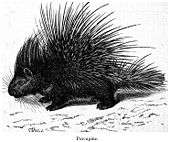Definify.com
Webster 1913 Edition
Spine
Spine
,Noun.
1.
(Bot.)
A sharp appendage to any of a plant; a thorn.
2.
(Zool.)
(a)
A rigid and sharp projection upon any part of an animal.
(b)
One of the rigid and undivided fin rays of a fish.
3.
(Anat.)
The backbone, or spinal column, of an animal; – so called from the projecting processes upon the vertebrae.
4.
Anything resembling the spine or backbone; a ridge.
Webster 1828 Edition
Spine
SPINE
,Noun.
1.
The back bone of an animal.2.
The shin of the leg.3.
A thorn; a sharp process from the woody part of a plant. It differs from a prickle, which proceeds form the bark. A spine which proceeds from the bark. A spine sometimes terminates a branch or a leaf, and sometimes is axillary, growing at the angle formed by the branch or leaf with the stem. The wild apple and pear are armed with thorns; the rose, bramble, gooseberry. &c. are armed with prickles.Definition 2025
spine
spine
See also: spiné
English
 The spines of some books on the English language
|
 A drawing of the human vertebral column or spine, from Gray's Anatomy (20th ed., 1918)
|
 A drawing of an Indian crested porcupine (Hystrix indica), with a coat of spines
|
Noun
spine (plural spines)
- The series of bones situated at the back from the head to the pelvis of a person, or from the head to the tail of an animal; backbone, vertebral column.
- 1851, Herman Melville, Moby-Dick, chapter 80:
- If you attentively regard almost any quadruped's spine, you will be struck with the resemblance of its vertebrae to a strung necklace of dwarfed skulls.
- 1918, W. B. Maxwell, chapter 16, in The Mirror and the Lamp:
- The preposterous altruism too! […] Resist not evil. It is an insane immolation of self—as bad intrinsically as fakirs stabbing themselves or anchorites warping their spines in caves scarcely large enough for a fair-sized dog.
- 1851, Herman Melville, Moby-Dick, chapter 80:
- Something resembling a backbone, such as a ridge, or a long, central structure from which other structures radiate.
- 1838, Samuel Hare, Practical Observations on the Causes and Treatment of Curvatures of the Spine: With Hygienic Directions for the Physical Culture of Youth, as a Means of Preventing the Disease; an Etching and Description of an Apparatus for the Correction of the Deformity, and Engravings Illustrative of the Cases, London: Simpkin, Marshall & Co. [et al.], OCLC 13279270, page 76:
- [Describing scoliosis.] The integuments over the abdomen are folded or wrinkled, the left breast is seldom fully developed, the ribs lose their natural shape, those of the left side becoming straighter, while, on the right side, they are so much curved, as to admit of their being easily grasped by the hand; they are closer together on the left side, and frequently rest upon the spine of the ilium, thus giving the right side a fuller and more rounded appearance than is natural.
- 1994, Howard S. An; J. Michael Simpson, Surgery of the Cervical Spine, London: Martin Dunitz, ISBN 978-1-85317-104-8, page 14:
- The posterior muscles of the neck are divided into superficial, intermediate, and deep groups. The most superficial muscle is the trapezius, which originates from the external occipital protuberance and the medial nuchal line of C7 to T12 spinous processes and inserts onto the spine of the scapula, acromion, and the lateral aspect of the clavicle.
- 2007, Peter Hyatt, Masters of Light: Designing the Luminous House, Mulgrave, Vic.: The Images Publishing Group, ISBN 978-1-86470-172-2, page 242:
- The eastern tower and the smaller western satellite are linked by the lift core, which passes through the centre of the monorail turning circle and provides the structural spine of the building; the two towers are cantilevered from this spine.
- 2007, Sergei Matveev, Algorithmic Topology and Classification of 3-Manifolds, 2nd edition, Berlin: Springer Science+Business Media, ISBN 978-3-540-45899-9, page 75:
- The polyhedron P∪D is a special spine of the twice punctured M, that is, of M with two balls B1, B2 cut out of it. To get a spine of M, we make a hole in c′ or c″ depending on which of them is a common face of these balls.
- The narrow, bound edge of a book.
- 1994–2014, “Rare Book Basics: Book Terms Illustrated”, in Powell's City of Books, archived from the original on 5 July 2014:
- The spine is the book's backbone. Because the spine is generally all you can see when a book is on the shelf, the spine displays the title and author of the book and is often ornately decorated.
-
-
- A pointed, fairly rigid protuberance or needle-like structure on an animal, shell, or plant.
- 1871, Charles Darwin, Descent of Man, chapter XII:
- The male, as Dr. Gunther informs me, has a cluster of stiff, straight spines, like those of a comb, on the sides of the tail.
- 1871, Charles Darwin, Descent of Man, chapter XII:
- (figuratively) Courage or assertiveness.
- 2001, Sydney I. Landau, Dictionaries: The Art and Craft of Lexicography, Cambridge: Cambridge University Press, ISBN 978-0-521-78512-9, page 409:
- Trademark Owners will nevertheless try to dictate how their marks are to be represented, but dictionary publishers with spine can resist such pressure.
-
- The stiffness of an arrow.
Synonyms
- (sharp protuberance from a living thing): needle; quill (on animals, flexible); spike (rigid); virgula (obsolete)
Derived terms
Terms derived from spine
Translations
backbone
|
|
bound edge of a book
rigid, pointed surface protuberance or needle-like structure on an animal, shell, or plant
|
|
metaphor for courage or assertiveness